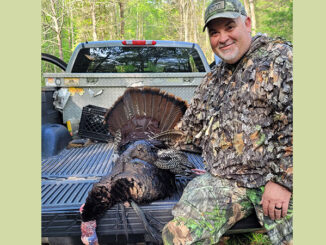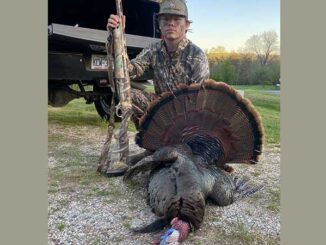
Laydown trees are great places to find and catch bass on Randleman Lake when the weather is hot.
July is a tough months to catch bass in shallow water on most lakes in North Carolina, unless you’re there at the crack of dawn to take advantage of the last few minutes of the night bite.
The water is just too hot, unless the lake has a strong inflow of cooler water, which is rare except in mountain reservoirs. So pull out your crankbaits and Carolina rigs and head for deep water.
Except, that is, at one Piedmont lake that’s one of North Carolina’s newest large impoundments: Randleman Reservoir on the deep river along the border between Guilford and Randolph counties.
“Randleman is a terrific bass lake, even during the summer,” said guide Joel Richardson of Kernersville, a former pro bass fisherman who guides on a handful of reservoirs but prefers Randleman during the summer.
“Even in the dead of summer, you can catch bass when the water temperature is 80 degrees or higher,” Richardson said. “It’s amazing. All you need to do is get there early enough and work the shorelines until the sun gets up. That’s usually a couple of hours. Then you can look for fish in deeper water.
“The nice thing about deep water at Randleman is it has many channels near shorelines, and it has lots of laydown trees over those channels.”
Chug Bugs, Pop-Rs or Spooks and Spook Juniors are all lproductive lures for working the shoreline for an early topwater bite, along with white or chartreuse buzzbaits.
Although it’s a relatively young lake, Randleman is already changing. There aren’t as many woody stickups as there were a few years ago where Richardson could fish topwaters around them and expect bass to blow up on almost every cast.
“Every lake seems to hit its best stride about six years after it opens, but this lake isn’t dropping off,” he said. “It’s just that sometimes you have to go to different places to find bass and fish a little differently.”
The lake opened to the public in March 2006, although it was ready for fishing two years earlier. The wait was for the governing Piedmont Triad Regional Water Authority to make sure its pumping station was ready to channel water to Greensboro, High Point and Randleman before allowing public access to the 3,007-acre lake.
“Now what you need to look for in the summer are laydowns, trees that have fallen in the water with their tops over deeper water, often over channels,” Richardson said.
Last July, Randleman’s largemouth bass regularly scavenged around those tree tops because shad were in those areas. With most of the lake’s brushy structure and small stickups dissolved after five or six years of full pool, baitfish learned that the ends of laydowns offered protection from predators.
Bass fishermen can credit N.C. Wildlife Resources Commission technicians and PTRWA workers for cutting plenty of shoreline trees, especially in 2012 and 2013, and letting them fall into the lake but cabling them to stumps to keep them on the shoreline. Now, they provide cover for shad, other baitfish, crappie and bream while at the same time setting the dinner table for bass.
Richardson figured out the laydown pattern one morning last July when his efforts to catch bass the way he had on past outings came up empty. He tied on a 7 1/2-inch, green pumpkin Zoom Mag 2 worm and rigged it Texas-style with a light bullet weight and fired it to the end of a tree hanging over a deep channel. He let the worm flutter down through the tree limbs, lifting it slowly over each limb before allowing it to drop some more.
Suddenly he snapped his rod tip toward the sky.
“What’s happened was basically I was lucky,” Richardson said. “The tree was 60-feet long, and the tops of the limbs at the end were 5 feet below the surface. But those tree tops were right over a creek channel that was 20- to 30-feet deep.
“I never felt the bite, but I felt something get tight, and I knew that was right so I set the hook.”
The result was a 4 1/2-pound largemouth.
“I think I’ve finally figured out the pattern,” said Richardson, who noted that the surface water temperature had been 68 degrees that morning. “All the rain we had and the low temperatures we had changed the bait patterns…. The shad have gotten on a fall pattern. It’s what they do when the water cools down.
“Usually shad come to the surface in the fall, then go to the backs of coves where the oxygen level is higher,” he said. “In July and August, the water level is low most years, but when we get rains flowing into the creeks, the run-off has a higher oxygen level, and it also causes plankton to bloom and puts out oxygen, and the shad go straight to it.”
After his discovery, Richardson motored to laydowns cabled to the bank near channels and caught bass the rest of the day, including a 5 1/2-pounder and a 6-pounder.
“Three or four years ago, this lake had mainly 2- to 3-pound bass, but now they’ve grown so quickly because of all the shad in the lake,” he said. “They’re averaging 2 1/2 to 5 1/2 pounds now. Several 8- to 10-pounders have come out of here the last several years.”
Richardson also found bass on the dead trees scattered along the shoreline at three sides of the US 220 Bridge.
He used the identical technique — a plastic worm with a light Texas rig — to catch a handful of them.
“You have to know this isn’t a normal pattern for July bass at this lake, but you have to be flexible,” Richardson said. “If a pattern worked well before, that doesn’t mean it’s always going to work another day, so the best thing to do is to try something different.
“If you’re not finding bass where you’ve always found them, then you have to try somewhere else. The key today was looking for baitfish.
“Randleman has got fish and some nice-size ones, and they’ll bite in the dead of summer. But like anything else in the outdoors, you first have to find out where they are.
“I’d rate the lake right behind Shearon Harris as the second-best bass lake in the state.”
DESTINATION INFORMATION
HOW TO GET THERE — US 220/I-73 crosses Randleman Reservoir between Greensboro and Asheboro. Take the Level Cross exit and turn right onto Branson Mill Road, then left onto Adams Farm Rd. Entrance to the park and reservoir is a mile south.
WHEN TO GO — March through October. Operating hours from May 1 to Aug. 1 are 6 a.m. to 8 p.m. and from Sept. 1 to Oct. 31 are 7 a.m. to 7 p.m.
BEST TECHNIQUES — Texas-rig plastic worms and lizards and fish them around tree tops, but keeps the weights light. In deeper water, go to Carolina-rigged soft plastics or deep-diving crankbaits. Topwater baits such as Spooks, Pop-Rs, Chug Bugs and buzzbaits will produce fish under low-light conditions. Rods should be 6- to 7-foot medium-heavy action baitcasters fitted with 4:1 retrieve-ratio baitcasting reels.
FISHING INFO/GUIDES — Joel Richardson, Joel Richardson Guide Service, 336-643-7214, www.joelgrichardson.com; Randleman Regional Reservoir Marina & Office, 7123 Adams Farm Road, Randleman, 336-498-5281. See also Guides and Charters in Classifieds.
ACCOMMODATIONS — Asheboro-Randolph Chamber of Commerce, 336-626-2626, www.chamber.asheboro.com.
MAPS — Piedmont Triad Regional Water Authority, 336-498-5281. Maps are also available at the lake office.









Be the first to comment